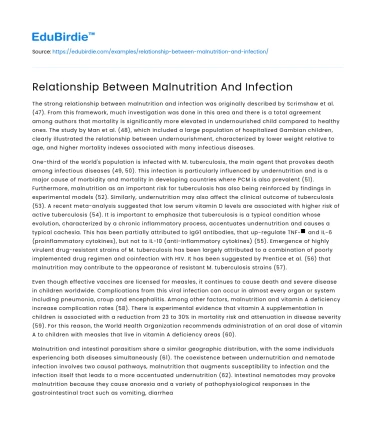The strong relationship between malnutrition and infection was originally described by Scrimshaw et al. (47). From this framework, much investigation was done in this area and there is a total agreement among authors that mortality is significantly more elevated in undernourished child compared to healthy ones. The study by Man et al. (48), which included a large population of hospitalized Gambian children, clearly illustrated the relationship between undernourishment, characterized by lower weight relative to age, and higher mortality indexes associated with many infectious diseases.
One-third of the world's population is infected with M. tuberculosis, the main agent that provokes death among infectious diseases (49, 50). This infection is particularly influenced by undernutrition and is a major cause of morbidity and mortality in developing countries where PCM is also prevalent (51). Furthermore, malnutrition as an important risk for tuberculosis has also being reinforced by findings in experimental models (52). Similarly, undernutrition may also affect the clinical outcome of tuberculosis (53). A recent meta-analysis suggested that low serum vitamin D levels are associated with higher risk of active tuberculosis (54). It is important to emphasize that tuberculosis is a typical condition whose evolution, characterized by a chronic inflammatory process, accentuates undernutrition and causes a typical cachexia. This has been partially attributed to IgG1 antibodies, that up-regulate TNF-α and IL-6 (proinflammatory cytokines), but not to IL-10 (anti-inflammatory cytokines) (55). Emergence of highly virulent drug-resistant strains of M. tuberculosis has been largely attributed to a combination of poorly implemented drug regimen and coinfection with HIV. It has been suggested by Prentice et al. (56) that malnutrition may contribute to the appearance of resistant M. tuberculosis strains (57).
Save your time!
We can take care of your essay
- Proper editing and formatting
- Free revision, title page, and bibliography
- Flexible prices and money-back guarantee
Even though effective vaccines are licensed for measles, it continues to cause death and severe disease in children worldwide. Complications from this viral infection can occur in almost every organ or system including pneumonia, croup and encephalitis. Among other factors, malnutrition and vitamin A deficiency increase complication rates (58). There is experimental evidence that vitamin A supplementation in children is associated with a reduction from 23 to 30% in mortality risk and attenuation in disease severity (59). For this reason, the World Health Organization recommends administration of an oral dose of vitamin A to children with measles that live in vitamin A deficiency areas (60).
Malnutrition and intestinal parasitism share a similar geographic distribution, with the same individuals experiencing both diseases simultaneously (61). The coexistence between undernutrition and nematode infection involves two causal pathways, malnutrition that augments susceptibility to infection and the infection itself that leads to a more accentuated undernutrition (62). Intestinal nematodes may provoke malnutrition because they cause anorexia and a variety of pathophysiological responses in the gastrointestinal tract such as vomiting, diarrhea and malabsorption. Together, these alterations deleteriously affect the host ability to get enough nutrients from the diet (63). Parasites that clearly affect the nutritional status are soil transmitted helminths, Giardia duodenalis, Entamoeba histolytica, coccidia and Schistosoma sp. (64).
There is also a general consensus that PEM is associated with greater malaria morbidity and mortality in humans (65). Supporting this observation, controlled clinical trials of either vitamin A or zinc supplementation indicated that these nutrients can substantially reduce clinical malaria outbreaks (66, 67). Opinions regarding the effect of certain micronutrients, as iron, for example, are still contradictory (68, 56).
Noma is an opportunistic infection promoted by extreme poverty that evolves rapidly from a gingival inflammation to mutilating orofacial gangrene. Even thought it can be observed worldwide, it is much more common in sub-Saharan Africa. It results from very complex interactions among malnutrition, infection and compromised immunity, and is very frequently preceded by malaria, measles and severe necrosating ulcerative gingivitis (69).






 Stuck on your essay?
Stuck on your essay?

